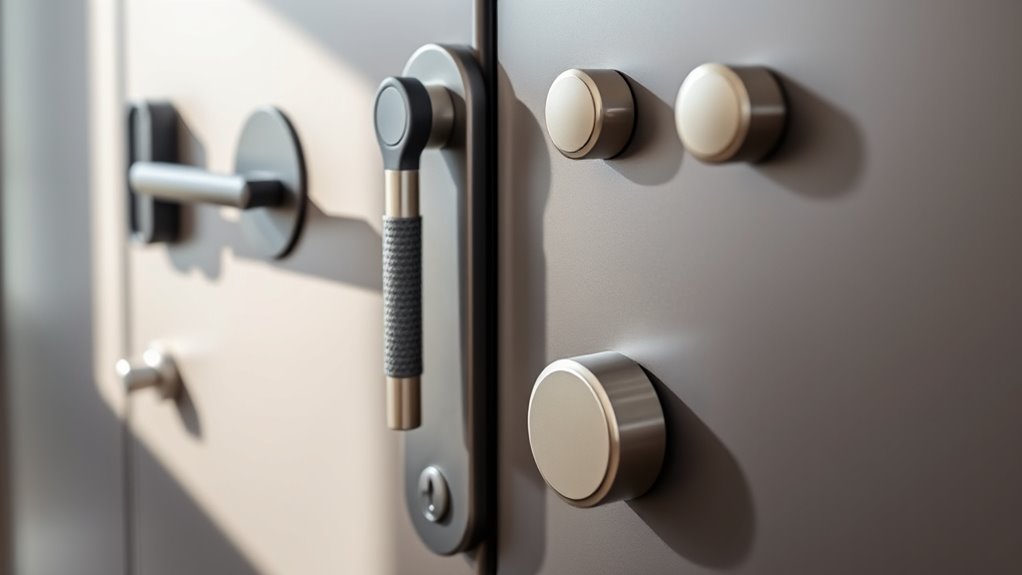Accessible door handles and levers are designed to make entry easier for everyone, including those with limited strength or dexterity. You’ll find options like lever-style handles, sensor-activated designs, and locks that enhance safety and independence. Choosing the right material, finish, and proper installation guarantees they look good and function well. Keep maintenance simple to prolong their life. If you keep exploring, you’ll discover even more tips to enhance accessibility and compliance.
Key Takeaways
- Different handle types like lever-style, sensor-activated, and lockable handles enhance accessibility and user convenience.
- Features such as ergonomic design, minimal force operation, and sensor activation promote ease of use for all users.
- Proper installation at recommended heights and secure attachment ensure compliance with ADA and building codes.
- Materials and finishes like stainless steel, matte, or satin improve durability, aesthetics, and grip.
- Regular inspection, cleaning, and timely replacement maintain accessibility standards and hardware functionality.
Types of Accessible Door Handles and Levers
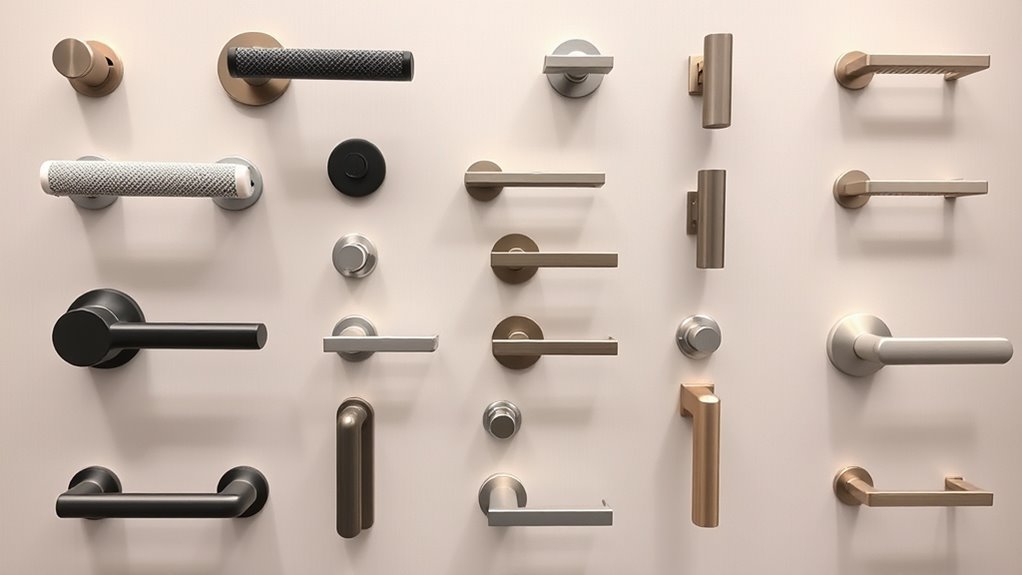
When choosing accessible door handles and levers, it’s important to understand the different types available. Sensor activation handles use motion sensors to open doors automatically, offering hands-free convenience for users with limited strength or dexterity. These handles are ideal for high-traffic areas or public spaces. Lever-style handles are also popular because of their ergonomic design, which requires less grip strength and offers easier operation compared to traditional knobs. Some lever handles incorporate sensor activation features, blending ease of use with modern technology. By understanding these types, you can select the best option to meet accessibility needs, ensuring that everyone can operate doors comfortably and safely. Choosing the right handle or lever enhances accessibility and user experience. Additionally, understanding the various handle types can help in selecting scenic views and natural beauty that make the environment more welcoming for all users.
Benefits of Lever-Style Door Handles
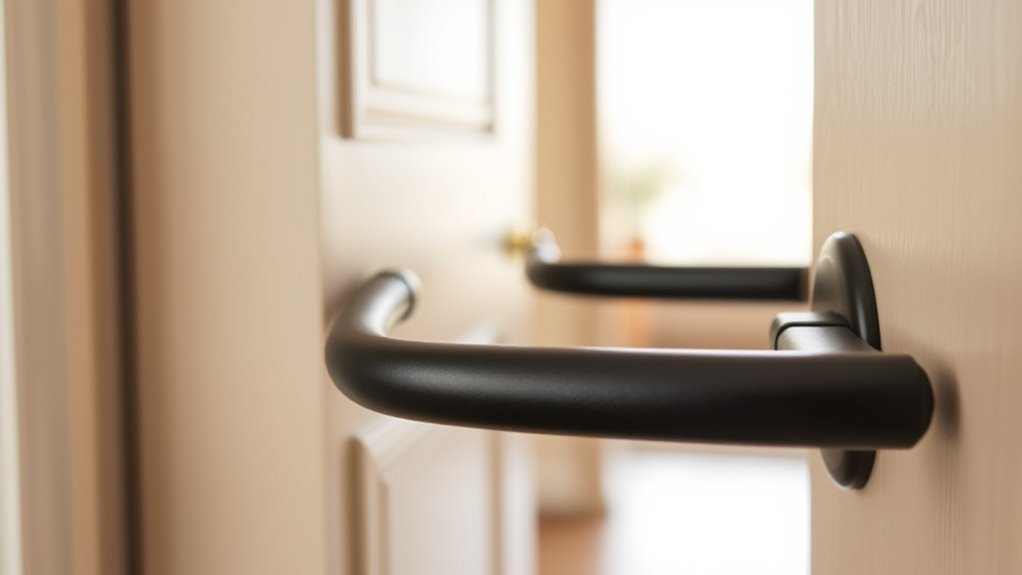
Lever-style door handles offer several key benefits that enhance accessibility and ease of use. Their ergonomic grip requires less effort, making them ideal for people with limited strength or dexterity. Unlike round knobs, levers can be operated with a simple downward push or pull, reducing strain and increasing efficiency. Additionally, lever handles often feature a sleek, modern design that boosts aesthetic appeal, blending seamlessly with various decor styles. This combination of functionality and style ensures you don’t have to safeguard looks for practicality. Whether in residential or commercial settings, these handles support independence and safety, making everyday tasks easier for everyone. Moreover, their user-friendly design can facilitate universal accessibility, promoting inclusive environments for all users. Overall, their user-friendly design and attractive appearance make lever-style handles a smart choice for accessible, stylish doors.
Features of Push-Button and Touch-Activated Handles
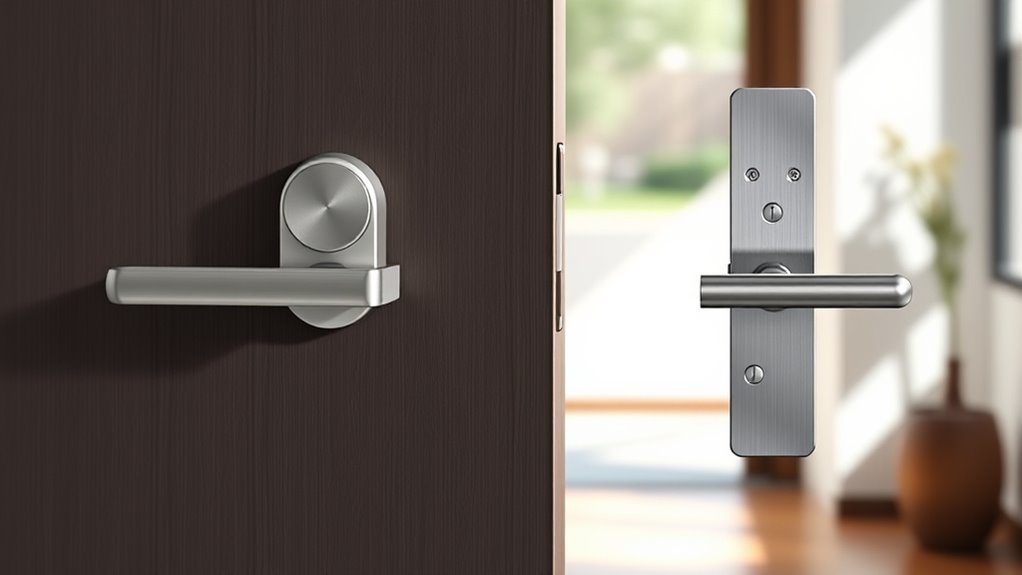
Push-button and touch-activated handles offer a sleek and hygienic alternative to traditional door hardware by eliminating the need for grasping or turning. These handles use sensor activation, allowing you to open doors with a simple touch or proximity. Their ergonomic design ensures comfortable use, reducing strain on your hand and wrist. Sensor activation provides a seamless experience, minimizing contact surfaces and promoting cleanliness, especially important in public spaces. Touch-activated handles are responsive and easy to operate, making them ideal for individuals with limited hand strength or dexterity. Overall, these features combine to create accessible, modern solutions that enhance safety, hygiene, and ease of use in various environments. Incorporating sensor technology into handle design not only improves user convenience but also aligns with the latest advancements in accessibility and safety standards.
Lever Handles With Locking Mechanisms

Lever handles with locking mechanisms combine ease of use with security features, making them a practical choice for both residential and public spaces. Their ergonomic design ensures that you can operate the lock comfortably, even with limited strength or dexterity. These handles often feature intuitive locking and opening functions, reducing frustration and increasing accessibility. Additionally, they contribute to the aesthetic appeal of your space, with sleek and modern designs that blend seamlessly with various decor styles. Whether for a bedroom, bathroom, or entry door, locking lever handles provide peace of mind while maintaining effortless operation. Their combination of ergonomic comfort and visual appeal makes them a versatile solution for enhancing accessibility without sacrificing style. Incorporating customizable options can further improve user experience by tailoring features to specific needs.
Material and Finish Options for Accessibility

Choosing the right material and finish for accessible door handles is essential to guarantee durability, safety, and ease of use. Material options like stainless steel, aluminum, and brass offer strength, corrosion resistance, and a sleek look. Each material provides different benefits, so consider your environment and user needs. Finish choices, such as matte, satin, or polished, influence grip, visibility, and maintenance. A matte or satin finish reduces glare and fingerprints, making handles easier to grasp and keep clean. Bright finishes like polished chrome may look attractive but can show fingerprints more easily. Selecting the appropriate combination of material and finish ensures your handles are both functional and aesthetically suitable, enhancing accessibility without sacrificing style or longevity. For added confidence, verifying the trustworthiness of brands like Patchology can help ensure quality and authenticity.
Considerations for Installing Accessible Handles

Proper installation is crucial to guarantee accessible door handles function effectively and meet user needs. You should evaluate cost considerations to confirm the installation remains within budget while maintaining quality. While accessible handles may have higher upfront costs, they often save money long-term by reducing maintenance and replacement needs. Additionally, focus on aesthetic integration by selecting handles that complement your space’s design. Well-chosen handles can blend seamlessly with your decor, ensuring accessibility doesn’t compromise style. Position handles at the recommended height and confirm they’re easy to operate with minimal force. Proper installation also involves securing handles firmly to prevent damage or malfunction over time. Considering sound design principles, such as clarity and ease of use, can further enhance user experience. By considering both cost and aesthetics during installation, you ensure your accessible handles are both functional and visually harmonious.
Compliance Standards and Regulations
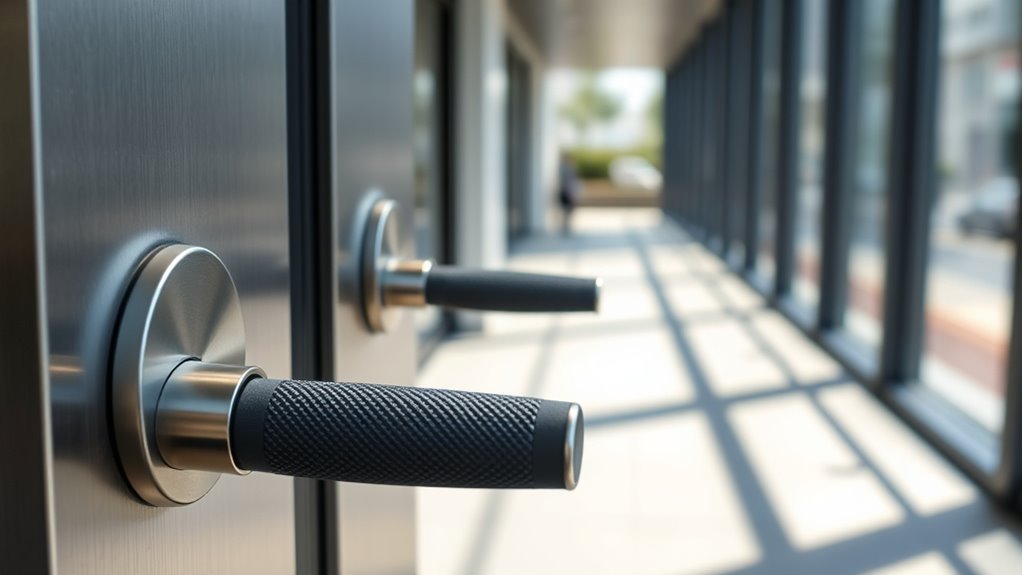
Are you aware of the key regulations that guarantee your accessible door handles meet legal standards? Ensuring ADA compliance is essential for your building’s accessibility and legal operation. Building regulations specify that door hardware must be easy to operate with one hand and require minimal force, making handles accessible for everyone. Compliance standards also dictate the height and placement of handles to allow universal access. Ignoring these regulations can lead to penalties, lawsuits, or barriers for users with disabilities. Regularly review local building codes and ADA guidelines to stay current. Properly installed, compliant handles not only meet legal requirements but also promote inclusivity and safety for all occupants. Additionally, understanding security considerations related to door hardware can enhance overall safety and protection. Staying informed about these standards helps you create accessible, compliant spaces that serve everyone effectively.
Tips for Maintaining and Replacing Accessible Hardware

To keep your accessible door hardware working smoothly, you need to regularly inspect it for wear and damage. Using proper cleaning techniques guarantees the hardware stays functional and hygienic, while addressing issues promptly prevents inconvenience. When parts become worn or broken, replacing them quickly is essential to maintain accessibility and safety.
Regular Hardware Inspections
Regularly inspecting your door handles and levers guarantees they remain accessible and functional. Check for signs of wear, loose screws, or damage that could hinder easy operation. Pay attention to hardware that seamlessly integrates with your smart home system, ensuring sensors and connectivity remain intact. If you notice issues, address them promptly to prevent further damage or accessibility concerns. During inspections, consider how aesthetic design choices impact usability—handles should look good but still be easy to grasp. Replacing worn or damaged hardware keeps your doors functional and maintains the overall safety of your space. Regular inspections also help you identify opportunities to upgrade to more advanced, accessible options that blend well with your existing decor and smart home features. Additionally, considering the horsepower of electric dirt bikes can inspire the selection of durable hardware capable of withstanding frequent use and environmental exposure.
Proper Cleaning Techniques
Keeping your accessible door handles and levers clean is essential for guaranteeing smooth operation and longevity. Establishing a regular cleaning schedule helps prevent dirt buildup and maintains hygiene. Use appropriate sanitization methods, such as disinfectant wipes or solutions recommended for hardware, to effectively eliminate germs without damaging the finish. Avoid abrasive cleaners that could scratch or corrode the surface. Focus on high-touch areas, cleaning them at least once daily or more frequently during busy periods. Always follow manufacturer instructions for cleaning products to ensure compatibility. After sanitizing, dry the handles thoroughly to prevent moisture damage. Regular maintenance and proper cleaning practices can also extend the lifespan of your hardware filter replacement and help prevent performance issues. Consistent maintenance not only keeps the hardware functioning smoothly but also creates a safe, hygienic environment for all users.
Timely Replacement Procedures
When you notice signs of wear, damage, or malfunction in your accessible door handles and levers, it’s crucial to replace them promptly to guarantee continued safety and ease of use. Delaying replacements can hinder access during emergencies or compromise vandalism prevention efforts. Regularly inspect hardware for loose parts, corrosion, or cracks, especially near emergency exit routes. If handles become sticky or unresponsive, replace them immediately to ensure quick, effortless operation. Use compatible, ADA-compliant hardware to maintain accessibility standards. Timely replacements also deter vandalism, as damaged or malfunctioning handles attract tampering. Keep spare parts on hand for swift repairs, and schedule routine checks to prevent issues from escalating. Proper maintenance and prompt replacement ensure your accessible doors remain safe, functional, and vandalism-resistant. Incorporating Pimple Patch solutions can also help maintain a clear and healthy appearance around hardware areas, reducing the likelihood of skin irritation from frequent handling.
Frequently Asked Questions
Are Accessible Door Handles Suitable for Outdoor Environments?
You might wonder if accessible door handles are suitable for outdoor use. Generally, they can be, but you should check for weather resistance and material durability. Look for handles made of rust-resistant metals or weatherproof plastics, ensuring they withstand rain, wind, and sun. Properly designed outdoor handles prevent corrosion and wear, maintaining accessibility and safety over time. So, choose handles specifically rated for outdoor environments to guarantee longevity and functionality.
How Do I Choose the Right Handle Size for Different Doors?
When choosing handle size, consider handle dimensions and door compatibility to guarantee ease of use. Measure the door’s thickness and existing handle placement, then select a handle that fits comfortably without protruding or causing obstructions. Opt for handles with suitable dimensions for your door type, whether it’s a standard or specialty door. Properly sized handles not only enhance accessibility but also ensure durability and a seamless fit.
Can Accessible Handles Be Installed on Existing Door Hardware?
Think of your door as a blank canvas waiting for a brushstroke of accessibility. Yes, accessible handles can be installed on existing door hardware, making it easier for everyone to use. You’ll find retrofit options that fit seamlessly with your current setup, and custom modifications guarantee a perfect fit. With the right tools and expertise, you can transform your door into an inclusive entry point—no need to start from scratch.
What Is the Average Lifespan of Accessible Door Handles?
The average lifespan of accessible door handles depends on material durability and maintenance frequency. You can expect handles made from sturdy metals like stainless steel to last 10-15 years with regular cleaning and minimal wear. Frequent maintenance, such as tightening screws and addressing corrosion, extends their lifespan. If handled gently and maintained properly, your accessible door handles will stay functional and reliable for many years.
Are There Any Special Cleaning Requirements for Accessible Hardware?
You should follow specific cleaning protocols for accessible hardware to guarantee longevity and hygiene. Regular maintenance routines involve using gentle, non-abrasive cleaners and avoiding harsh chemicals that could damage the finish or mechanisms. Wipe handles and levers with a soft cloth, and disinfect frequently touched surfaces to prevent germs. Proper upkeep keeps your hardware functioning smoothly and maintains its accessibility features, ensuring safety and usability for all users.
Conclusion
Choosing the right accessible door handles isn’t just about compliance—it’s about opening doors to greater independence and inclusivity. By understanding your options and considering installation and maintenance, you create a space that welcomes everyone. Remember, accessibility isn’t a feature; it’s a reflection of your commitment to equality. When you select thoughtfully, you turn a simple handle into a symbol of empowerment—proof that even the smallest details can make the biggest difference.
